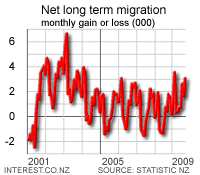Opinion: Seasonal adjustment gives further reason to believe that housing upturn has started
our pay-to-view reports we regularly present seasonally adjusted data for the likes of house sales, residential building consents and migration but understandably to a number of people we are talking gobbledegook when we refer to seasonally adjusted data. So this Raving takes an educational bent in explaining why some data are adjusted for seasonal patterns and how to interpret seasonally adjusted data using insightful real world examples and plain English.
The monthly number of people arriving in NZ on a permanent or long-term basis exhibits classical seasonal behaviour. The number of arrivals peaks in January in most years while it is always also elevated in February and occasionally peaks in February. The number of arrivals is normally at its lowest in May and occasionally in April.
 Understandably more people like moving to NZ in the peak of summer than heading into winter. Mathematical packages have been developed that remove the seasonal pattern from the data, with the resulting adjusted data showing if the number of arrivals are higher or lower than normal for the particular time of year (e.g. is the peak number in January higher or lower than normal?).
Understandably more people like moving to NZ in the peak of summer than heading into winter. Mathematical packages have been developed that remove the seasonal pattern from the data, with the resulting adjusted data showing if the number of arrivals are higher or lower than normal for the particular time of year (e.g. is the peak number in January higher or lower than normal?).
The seasonally adjusted data can be a bit noisy or volatile if the seasonal pattern in the actual data isn’t stable and/or the actual data are volatile. So as well as seasonally adjusting data to get a better understanding of what is happening to the underlying trend in the numbers we often also take two-month or three-month averages.
The monthly number of dwelling sales reported by REINZ also exhibits seasonality but not the classical seasonality evident in the migration data. The 3,706 dwellings sold by real estate agents in January was generally reported as being exceptionally low.
 The commentary we saw on the January number focused on the 14% fall from December and the 28.5% fall from January 2007, which gives the impression that the market was in free fall. But it is normal for the number of sales in December and January to be much lower than in November. This is because of the impact of holidays. The number of sales in January is more often than not lower than in December.
The commentary we saw on the January number focused on the 14% fall from December and the 28.5% fall from January 2007, which gives the impression that the market was in free fall. But it is normal for the number of sales in December and January to be much lower than in November. This is because of the impact of holidays. The number of sales in January is more often than not lower than in December.
Since 1989 the number of sales reported by REINZ has on average fallen by 20.6% between November and the following January, while in the last five years the average fall has been 27.5%, both of which make the 13.4% fall from November 2008 to January 2009 look smaller than normal (i.e. once we take the normal seasonal pattern into account the outcome this January is better than normal not worse!).
We then look at the number of REINZ dwelling sales after they have been adjusted to remove the seasonality with the seasonal adjustment package we use. Once the seasonal pattern is taken into account the really low number was in November 2008, while December 2008 and February 2009 showed signs of life after death.
It is normal for the actual number of sales in March to be higher than the number in February although this wasn’t the case in 2008 because the market was in free fall then, so we will only have an upturn on our hands if the number of sales this month is at least moderately higher than was reported for February.
The weekly data the RBNZ supplies on the number of housing loan approvals by banks gives another example of strong seasonality. The number of approvals tumbles in the last month of the year because of the impact of Christmas, remains particularly low in the first week of January because of the impact of New Year and is also significantly below average in the second week of January because many people including most lawyers are on holiday.
There is also a general tendency for the number of loan approvals to be higher over the summer months and lower during winter.
While the seasonally adjusted data don’t exhibit the dramatic plunge evident in the actual numbers in the last week of December and the first two weeks of January it is volatility. The volatility can be particularly evident around the Christmas-New Year period because the days of the week that the statutory holidays fall on changes from year-to-year, with the same applying to the Easter period because it falls in different weeks from year-to-year.
Some seasonal adjustment packages are more sophisticated than others and can take account of changes in the number of trading days per month or per week which the simple package we use doesn’t. But if the underlying seasonality in the data isn’t stable then even the most sophisticated adjustment package will spit out data that exhibit volatility and warrant caution in interpreting.
In the context of the seasonally adjusted loan approval data our interpretation is that an upturn is underway but the volatility is such that it is hard to say how strong it is. To remove the volatility we have to take a twelve-week moving average which shows a pretty strong upturn and gives some further reason to believe that a housing upturn has started.
This article has kindly been republished courtesy of interest.co.nz.
To view this article and other news updates from
Posted: 23 Mar 2009
News articles
Browse articles
by date


